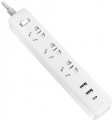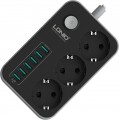Cable length
The length of the cable used to connect the surge protector to the network.
The longer the cable, the farther from the outlet you can install the device. On the other hand, a long cable can be inconvenient over short distances. Models on a coil are deprived of this drawback (see "Type"), this moment is compensated by the actual presence of the coil, but they differ in large dimensions and heavy weight. So when choosing, it is far from always worth chasing the maximum length of the wire.
Wire section
The cross-sectional area of the wire used to connect the filter to the network. The larger the cross-sectional area, the thicker the wire, the more reliable it is and the more current it can pass without overheating. Accordingly, thick wires (
1.5 mm² and
2.5 mm²) are a must for high power devices. At the same time, modern manufacturers, usually, choose the cross-sectional area in such a way as to guarantee the safe operation of the filter at the claimed maximum power (see above). Therefore, in fact, a model with a thicker cable than other similar devices should be chosen if it is supposed to be used in unstable networks in which power surges often occur. If the cross-sectional area seems too small for you (
0.75 mm² or
1 mm²) for the claimed power, there are special formulas that allow you to check the validity of such doubts.
Grounded sockets (type F)
The number of
sockets with type F grounding, provided in the design of the mains filter.
In this case, we are talking about full-size European type F sockets with metal ground clamps on both sides at the edges of the socket. The "socket" in this case means a CEE 7/4 ("Schuko") standard plug. Grounding is required for the safe operation of some types of electrical appliances, in particular, washing machines and other machines that work with water, refrigerators, computers, audio equipment, etc. A detailed list can be found in the reference literature. If you plan to connect such devices through the filter, this filter must have sockets with grounding.
International plug
The number of
universal sockets in the filter, compatible with several types of plugs at once.
Most often, such sockets are made compatible with three types of plugs: a standard “Euro plug” used in Europe and the post-Soviet space, an American Type A plug (two parallel flat contacts) and a Type I plug used in China and Australia (three flat contacts at an angle ). The filter for international plugs is useful for those cases when the household has equipment with different types of plugs — it will allow you to do without additional adapters.
USB A
The number of
USB ports for charging, provided in the design of the surge protector.
Such ports do not perform any other function than powering and charging external devices such as smartphones or tablets. The presence of such connectors in the surge protector can be especially convenient when there is no “230-to-USB” adapter at hand, and there are few USB ports in a computer or laptop and using them for charging is “an unaffordable luxury”.
USB C
The number of USB-C ports in the network filter design.
Such ports do not perform any other function than powering and charging external devices such as smartphones or tablets. The presence of such connectors in the surge protector can be especially convenient when there is no “230-to-USB” adapter at hand, and there are few USB ports in a computer or laptop and using them for charging is “an unaffordable luxury”.
Max. charging current
The current output by a USB connector when a charging gadget is connected to it.
The higher the current, the faster the battery can charge. However, when choosing, note that in order to use a high current strength, the connected device must also support it. Basically there are
USB with a current strength of 2.1 A,
2.4 A and
3 A.
It is also worth noting that when using several USB ports at the same time, the current strength is significantly reduced.
Power (with 1 device)
The maximum power that a USB port can produce when connecting only one gadget.
Higher power output speeds up the charging process. At the same time, there are a number of nuances associated with this parameter. Firstly, the appropriate power must be supported not only by the port, but also by the gadget being charged - otherwise the speed of the process will be limited by the characteristics of the gadget. Secondly, to take full advantage of the capabilities, you may need to support not only the appropriate charging power, but also a specific fast charging technology. Thirdly, in filters with several charging connectors, the maximum power per device can only be achieved if the other ports are not used.
Charge current
Current value for all USB ports of the device. Allows you to understand how much maximum you can squeeze out of the device, i.e. how much current will be supplied to each port at maximum load. As for the maximum value of the current strength, it cannot be determined by this indicator.

